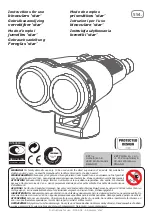
INSTRUCTION MANUAL
OVERVIEW
Compact Night Vision Monocular
Polaris
was created for
hunting, paintball, strike ball enthusiasts and anybody,
who wants to see during the night time an object at a
distance of up to 200 meters.
Polaris
is equipped with a
built-in powerful IR illuminator (7) that enables clear
viewing in low ambient light conditions.
Polaris
has a high-aperture objective lens with a wide field
of view and especially designed night vision lenses. The
lens focusing ring provides a fast, precise and efficient
way to quickly focus on objects, making
Polaris
a perfect
fit to observe moving objects.
Polaris
is furnished with a
built-in automatic shut off system to protect the image
intensifier tube in the event of excessive light exposure.
Polaris
will turn off after 2 seconds, when exposed to
intense light source.
OPTICS
BATTERY INSTALLATION
Ensure that the battery is inserted with the polarity in the
direction shown on the battery compartment cap (6).
To secure the battery compartment cap, turn it clockwise
until tight.
The energy efficient design allows
Polaris
to function
without turned on IR illuminator up to 60 hours from one
lithium battery CR-123.
NOTE:
It is acceptable to use alkaline and rechargeable
(nickel-cadmium) batteries of the above indicated
standard, however the running time from one battery might
vary
•
Insert battery (one CR-123 battery).
•
Remove protective objective lens cover (2) from the
objective
(1
).
NOTE:
It is advised to turn the unit on only in low light
conditions. If necessary to test the unit in bright light
conditions, leave the protective objective lens cover on
(2).
•
To turn the unit on, press the
ON
button (3). The green
LED indicator
(8)
will turn on and there will be green light
in the eyepiece (5).
•
To use the unit in the total darkness conditions, e. g.
cellar, ravine, etc, turn on IR illuminator
(7)
by pressing
button
IR (4).
When the IR illuminator is on, the red LED
indicator
(9)
will turn on.
NOTE:
The IR illuminator can be seen by other night
vision devices and the operator will no longer be invisible.
•
Direct the
Polaris
at the observed object. To focus, rotate
the objective lens (1) and eyepiece (5) until the image is
sharp and clear. To focus at the object at a different
distance, it is sufficient to only adjust the objective lens
(1).
•
To turn the unit off, press the
ON
button (3) and replace
protective objective lens cap cover (2).
WARNINGS AND PRECAUTIONS
•
After the unit usage in temperatures below zero, wait at
least 3 hours at room temperature, to avoid condensation
accumulating on the internal lens surfaces and the
consequent fogging caused by extreme temperature
differences.
Green LED indicating
9
Scope"on"
•
Do not disassemble the unit and attempt to use it that condition.
•
To clean, use clean soft cloth dampened in alcohol, if necessary.
•
Never pour alcohol or any other liquids directly onto lens surfaces.
•
Never use paper or newspaper to clean the unit.
Failure to follow the above precautions may cause the unit damage and will void
the manufacturer's warranty.
STORAGE
Always store the unit in its carrying case in a dry well ventilated space in temperature
above +15°C (60° F). Do not store near heating devices. Do not store in direct sunlight or
high humidity conditions (higher than 70
%).
Remove battery for prolonged storage.
OBSERVATION DISTANCES
The object
distance is not a constant measure and is determined by the
following factors: natural light conditions, sky clarity and contrast between the observed
object and its background.
The object recognition distance increases in good light conditions, full moon or with help
of IR illuminator, or for an object situated on light background, e. g. sand, snow, etc. The
object recognition distance substantially decreases in low light conditions, cloudy sky, or
foran object situated on dark background, e. g. trees, etc.
The below table offers
distances of a human figure with contrast
background for various generations of night vision devices:
1
Red LED indicating
jlRllluminator"on"
··········
O
" '
/,..;-




















